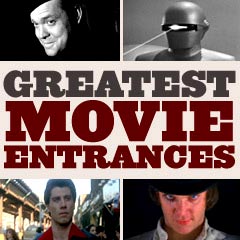
|
![]()
| Movie Title/Year and Film Character with Scene Description | ||||||||
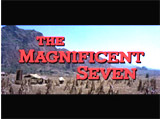
|
The Magnificent Seven (1960)
Director John Sturges' legendary western has often been acknowledged as a remake of Japanese director Akira Kurosawa's Seven Samurai (1954). The ensemble film involved seven gunslingers who served as a vigilante force to protect a terrorized Mexican town and its oppressed peasant villagers from invading bandits, led by gold-toothed Calvera (Eli Wallach). The seven gunmen included:
A silent but deadly knife-thrower Britt was unforgettably introduced (nearly wordlessly) in a scene in which he was cooly reposing against a fence, when confronted by hot-headed, haughty gunman Wallace (Robert J. Wilke). In a knife-versus-gun fast draw between the two, Britt appeared to be the winner of their contest. He very simply confirmed for Wallace the general consensus of the other witnesses watching them: "You lost." When Wallace couldn't accept the fact that he had lost, he called Britt a "liar" and a "coward," and goaded Britt into a second deadly face-off. Wallace ended up the loser, with a knife in his chest, unable to draw faster than Britt. Immediately afterwards, Chris considered recruiting Britt into their team ("Can l have a word with you?"). |
 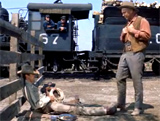 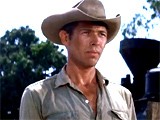 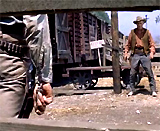 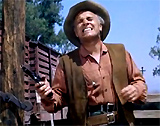 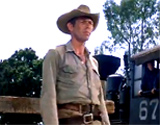
|
||||||

|
While an unsuspecting Marion Crane (Janet Leigh) showered in her Bates Motel room, a shadowy, grey tall figure entered the bathroom. Just as the shower curtain completely filled the screen - with the camera positioned just inside the tub, the silhouetted, opaque-outlined figure whipped aside (or tore open) the curtain barrier. The outline of the figure's dark face, the whites of its eyes, and tight hair bun were all that was visible - "Mrs. Bates" wielded a menacing, phallic-like butcher knife high in the air - at first, it appeared to be stab, stab, stab us - the victimized viewer! The piercing, shrieking, and screaming of the violin strings of Bernard Herrmann's shrill music played a large part in creating sheer terror during the horrific scene - the string instruments started 'screaming' before Marion's own shrieks. Marion turned, screamed (her wide-open, contorted mouth in gigantic close-up), and vainly resisted as she shielded her breasts, while the large knife repeatedly rose and fell in a machine-like fashion. After "Mother" had disposed of Marion, she turned abruptly and left her to die on the floor of the bath tub. |
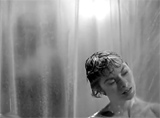 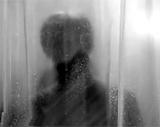  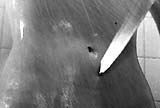
|
||||||
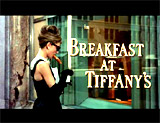
|
Breakfast at Tiffany's (1961)
In Blake Edwards' romantic comedy with Henry Mancini's Oscar-winning score and based upon Truman Capote's 1958 novella, waifish New York call girl Holly Golightly (Audrey Hepburn) was first introduced in the film's iconic opening scene. It was set to the mournful and wistful tune of Mancini's "Moon River." Early one morning (at dawn before the Fifth Avenue stores opened in NYC, when the streets were deserted), she elegantly slipped out of a yellow taxi cab. From a low angle, the camera looked up from behind her, at the imposing storefront of Tiffany and Co., at 727. Her name was representative of her nature - carefree and emotionally-detached. It marked the start of edgier roles for the innocent Hepburn. The sham "Cinderella" figure, a ditzy gold-digging prostitute ("party girl"), was window-shopping there. She was wearing sunglasses, and her hair was in a beehive configuration. Overdressed, she wore a slinky, Givenchy black evening dress decorated with pearls, and elbow-length black gloves. As she walked over to one of the fabled and enchanted Manhattan jewelry emporium's window displays, she began to eat her "Breakfast at Tiffany's" from a to-go white paper bag (coffee in a polystyrene cup and a dry pastry or croissant). She walked over to a second display window, where she gazed inside. She appeared captivated as she imagined herself amidst the priceless baubles. She then continued walking down the empty sidewalk, and turned the corner into the dawning gold light, where she tossed her cheap breakfast remains into a trash can. She receded into the distance. After a night on the town, she was enroute, via walking, to her NY brownstone where she often plied clients. The aspiring-to-wealth yet flightly female was born Lula Mae Barnes in Texas, originally the child bride of estranged pedophile husband Doc Golightly (Buddy Ebsen), although she claimed that the marriage had been annulled. |
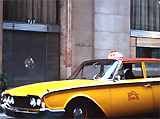 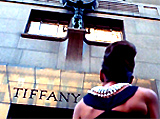 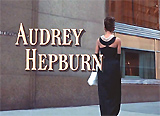 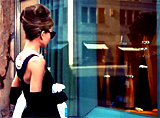 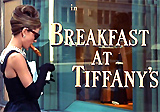 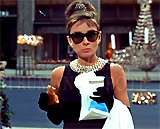
|
||||||
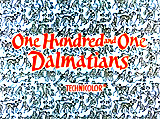
|
101 Dalmatians (1961) (aka One Hundred and One Dalmatians)
This Disney animated feature told about two characters and their partners:
However, there was also a villainous, savage antagonist ("a devil woman") named Cruella De Vil (Betty Lou Gerson) - a wild-haired, smoke-fiend female with a wicked laugh. After Roger and Anita married, and Pongo and Perdita produced 15 dalmatian puppies, Cruella made an introductory appearance to see Anita, a former school mate. Her dark silhouette was seen through the glass door as she rang the doorbell. She forced her way in, and immediately complained about being "miserable," with a trail of greenish-yellow smoke from her cigarette enveloping her. She explained her true obsession: "I live for furs. I worship furs." She then made a haughty insult about Anita's house: "This horrid little house is your dream castle," extinguished her cigarette in a cupcake, and then insulted Anita's husband: "and poor Roger - he's your bold and fearless Sir Galahad." She admired the beautiful 'fur' coats of Pongo and Perdita, and expressed her desire to purchase their litter of dalmatian puppies - implying that she would use their fur coats to manufacture a new coat for herself. Cruella promised to return in three weeks when the puppies were older, slammed the door behind her, and left in a hurry in her red car. |
 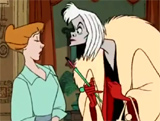 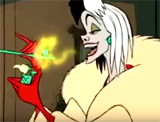 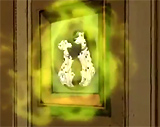
|
||||||

|
The build-up to the introduction of the famous secret agent James Bond (Sean Connery) in the fancy gambling casino, Le Cercle (Les Ambassadeurs, London) Club, was established with over a dozen different camera angles before Bond's face was actually seen. He was playing cards at one of the chemin de fer gaming tables against a beautiful, wealthy and sexy brunette who was losing named Sylvia Trench (Eunice Gayson). Their conversation was memorable:
In the film's most unforgettable sequence, Bond awakened in the Crab Key jungle to the sound of a girl's voice singing the calypso song "Underneath the Mango Tree." And then on the beach rising Venus-like from the water with giant seashells, Bond had his first view of Honey Ryder (Swiss actress Ursula Andress, voice-dubbed by Nikki van der Zyl). He was stunned with his first look at her - she became the first of many indelible Bond girls (although not literally the 'first' female to be with Bond). After singing a few lines of her song, his first words to her were: "It's all right. I'm not supposed to be here either. I take it you're not. Are you alone?...I'm just looking...I promise I won't steal your shells... I can assure you my intentions are strictly honorable." She was an innocent, voluptuous island girl/diver wearing a sexy, white bikini and hunting knife (which she pulled out, gestured threateningly and told him to stay where he was). She made a living by collecting Jamaican seashells and selling them to dealers in Miami.
|
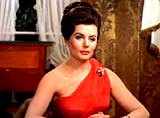 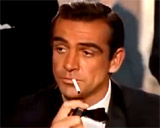 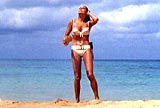 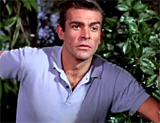 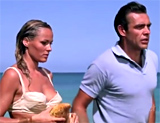
|
||||||
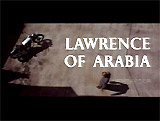
|
At a desolate Harith well at Masruh (belonging to a rival Bedouin tribe), Tafas drew up water at the start of one of the longest, most memorable, wide-screen film entrances in cinematic history. A dust cloud and then a tiny ghostly speck appeared through shimmering, mirage-like heat waves on the desert horizon - Lawrence (Peter O'Toole) feared it was "Turks." The ominous image, more mirage than real, steadily enlarged and grew into a human being as it came closer and closer. Was it friend or foe?
Tafas, Lawrence's escort, ran to his camel and pulled out a gun, but was shot down in cold-blood by the black-robed Bedouin. Tafas' gun fell at the feet of Lawrence, as he watched the shooter ride up, dismount, and approach the dead body. Tafas was murdered for drinking at the well owned by a rival tribe, without permission. Through this ugly, ferocious act of ancient Bedouin tribal warfare, a fearless Lawrence was introduced to black-clad Sheik Sherif Ali Ibn el Kharish (Omar Sharif) on camel-back. Their initial conversation was brief:
|
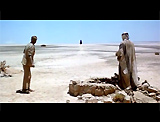 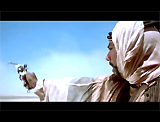 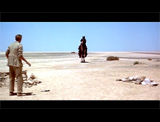 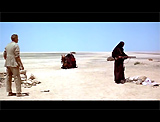
|
||||||
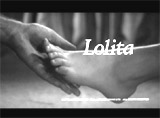
|
Middle-aged Professor Humbert Humbert's (James Mason) first look at young nymphet Lolita's (Sue Lyon) youthful figure was impossible for him to forget. She wore a two-piece skimpy, flower-patterned bikini, and she sported heart-shaped sunglasses and a broad-brimmed, feathered straw hat while sunning herself on a blanket laid on the rear lawn. Her mother Charlotte Haze (Shelley Winters) continued babbling on, oblivious to Humbert's smitten, bedazzled look and immediate infatuation:
Humbert quickly reconsidered her offer to rent a room for "something nominal, let's say, uh, two hundred a month... including meals, and uh, late snacks, etcetera...uh, you couldn't find better value in West Ramsdale." Charlotte was curious about what clinched the deal for him to move into the house: "What was the decisive factor? Uh, my garden?" Avoiding the truth, Humbert replied, tongue-in-cheek with a clever double entendre: "I think it was your cherry pies!" The scene ended on another long stare from Lolita. |
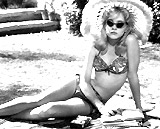 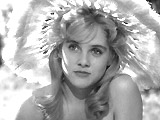
|
||||||
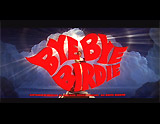
|
Bye Bye Birdie (1963)
Director George Sidney's adaptation of the Broadway musical hit opened with the stunning introduction of 22 year-old Ann-Margret as nubile 16 year-old vibrant Ohio high-schooler Kim McAfee. She was a member of a teen-idol fan club in Sweet Apple, Ohio, and the lucky one chosen to receive a farewell kiss ("One Last Kiss") from rock idol Conrad Birdie (Jesse Pearson), an Elvis-like singer (just before he was drafted into the military). The event was to be broadcast on the popular weekly TV variety program, The Ed Sullivan Show (although fictitious in the film). In the star-making opening credits sequence Kim flipped her skirt and tossed her hair as she sang the title song (written specially for the film) before a blue-screen and in a wind tunnel. Other cast members complained that their roles were shortened or cut (from the original), to make room for director Sidney's extra scenes with Ann-Margret, due to his infatuation with the striking young actress. |
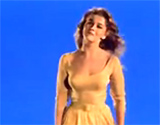 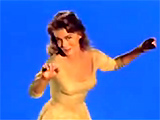 
|
||||||

|
The Nutty Professor (1963)
This farcical comedy was written, directed, and acted by Jerry Lewis. Over three decades later, it was remade by Eddie Murphy as The Nutty Professor (1996) - now obese - with Murphy playing most of the roles of the Klump family in the film. Jerry Lewis played a dual role (Jekyll-Hyde) as a nerdy college teacher Julius Kelp and as the ultra-smooth Buddy Love in this 1960s comedy. The two characters could be described as:
Upon his first appearance in the movie in the hip Purple Pit hang-out (a dance nightclub), frozen audience reaction shots prefaced the first view of the character. Was he a monster after drinking the potion?
No, he had become transformed into the lounge-lizard hipster and swinging extrovert Buddy Love (resembling Rat Packers Frank Sinatra and/or Dean Martin). After strolling to the bar, picking on the bartender while ordering a drink, he sang "That Old Black Magic" at the piano under subdued lighting - becoming loveably irresistible to co-star Stella Stevens (as Stella Purdy). |
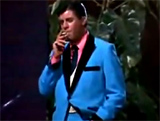 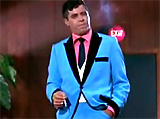 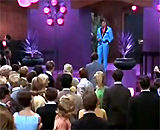
|
||||||
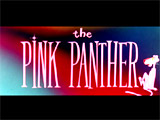
|
The Pink Panther (1963)
The first in a long, popular series of blockbuster sleuth-caper Pink Panther films was the original slapstick comedy The Pink Panther (1963) from director Blake Edwards, with the incomparable, bumbling, inept, trench-coated French police Inspector Jacques Clouseau (Peter Sellers in the first of five films), known for clumsy pratfalls. As in all the Panther films, the iconic pink panther appeared first in the animated opening credits. In this particular tale which began with the title: "Once Upon a Time...," a priceless gem was presented to a sultan Shah Lugash's young daughter (who would later grow up to be beautiful Indian Princess Dala (Claudia Cardinale)). The camera zoomed into the diamond - and the cartoon character of the Pink Panther appeared to perform antics with the lettering during the credits. Clouseau would soon be trailing a criminal known as The Phantom - a white-monogrammed glove-dropping, international jewel thief and British playboy, intent on stealing the priceless diamond with a pink panther discoloration or figure visible within the gem. [The thief was later revealed to be Sir Charles Lytton (David Niven), vacationing at a Swiss Alps ski resort, the Cortina D'Ampezzo in N. Italy, where the Princess Dala was also visiting. His plan was to romance her and then steal the priceless diamond.] The French-accented detective first appeared impatiently sitting at his desk in Paris. He rose, spun a huge world globe, and pronounced that they needed to find the first female "link" to the Phantom: "We must find that woman." He was swiftly thrown to the floor after touching the rotating globe a second time. His wife Simone (Capucine) entered - the actual 'woman' in question. Clouseau was unaware that she was the Phantom's accomplice and lover, who often warned the robber about Clouseau's whereabouts. Clouseau's sidekicks or cohorts, beginning with A Shot in the Dark (1964), included Clouseau-hating, mad Chief Inspector Charles Dreyfus (Herbert Lom) and houseboy Kato (Burt Kwouk) who taught martial arts to Clouseau via surprise attack. |
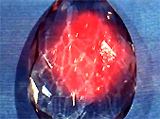  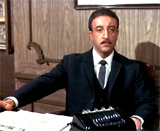 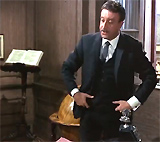
|
||||||

|
Dr. Strangelove Or: How... (1964)
President Muffley (Peter Sellers) called upon crazed Dr. Strangelove (Peter Sellers in his third role), a wheelchair-bound German (ex-Nazi) nuclear scientist and U.S. weapons strategist/director of weapons research and development, for background information about the Doomsday Machine. Strangelove, seated in a dark area at the circular War Room table, responded with a German accent: "A moment please, Mr. President," as he wheeled his shape into view. With thick dark sunglasses, Strangelove also had a black-gloved mechanical, robotic right hand, and his left hand shakily held his cigarette. He described how the US had abandoned its own plans for a Doomsday mechanism, yet added: "My conclusion was that this idea was not a practical deterrent, for reasons which, at this moment, must be all too obvious....The technology required is easily within the means of even the smallest nuclear power. It requires only the will to do so." Strangelove asserted that the essence of the Doomsday Machine was that it could be "triggered automatically" and also "impossible to untrigger." With fervent, Nazi-like ardor, he theorized:
|
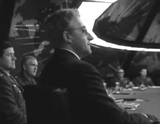 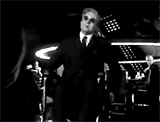 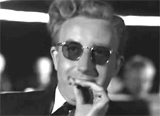 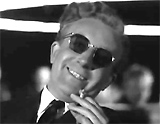
|
||||||
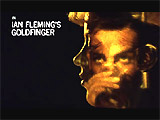
|
At the Fountainbleau Hotel in Miami, James Bond (Sean Connery) was keeping an eye on rich, greedy, gold-smuggling villain Auric Goldfinger (Gert Frobe). He first angered Goldfinger by disrupting and ruining his card-shark scam against a gin-rummy opponent. While he was seducing and romancing Goldfinger's pretty blonde assistant/escort Jill Masterson (Shirley Eaton) in his hotel suite, Bond momentarily went to the refrigerator for more Dom Perignon champagne ("passion juice"). He was knocked unconscious with a karate-chop to the neck from behind (a hand was first seen). It was delivered from a shadowy figure wearing a bowler-hat -- the signature look of Goldfinger's mute Korean henchman Oddjob (Harold Sakata). |
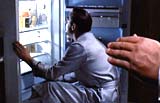 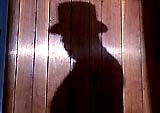 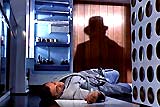
|
||||||

|
The most improbably-named Bond girl in the history of the film series was introduced in this memorable entrance scene. Appearing first as an unfocused blur above a tranquilized Bond (Sean Connery) onboard Goldfinger's jet, Bond girl Pussy Galore (Honor Blackman) came into view leaning over him. Bond asked:
She held a gun on Bond, although qualified its effectiveness: "Tranquilizer gun. Knockout shot." She stated proudly that she was Goldfinger's personal jet pilot, and they were both in a Lockheed JetStar heading for Baltimore. The villain had already flown ahead to orchestrate his Operation Grand Slam plan. After Bond ordered a "martini, shaken, not stirred," Pussy told him to quit being so forward:
She was hinting at her lesbian-leanings. |
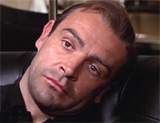 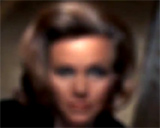 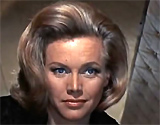 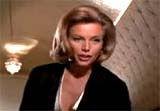
|
||||||
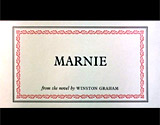
|
Marnie (1964)
Alfred Hitchcock's psychological thriller - a tale of sexual perversity and obsession - was actually a 'sex mystery.' The opening title credits were composed of a slide-show of 19 cards, revealed as pages turning from the right of the screen to the left. To begin his tale, director Hitchcock tantalized the audience with a prolonged series of sequences to cleverly and economically introduce clues to the main character's identity and appearance:
The title character Margaret 'Marnie' Edgar (Tippi Hedren), had been introduced as a blonde, a con artist, a liar and compulsive thief (kleptomaniac). |
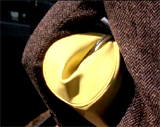 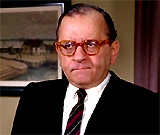  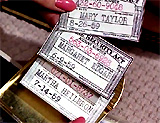 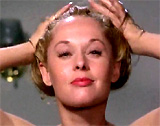
|
||||||

|
Mary Poppins (1964)
During the opening credits, nanny Mary Poppins (Julie Andrews), with her umbrella, floated into 1910 London on a cloud, as she applied makeup. However, she wouldn't make her real entrance into the film until about 20 minutes later. The Banks household had experienced six nannies in the last four months for their two disobediently playful children (Jane and Michael). The head of the household, stern and fastidious banker Mr. Banks (David Tomlinson), placed a new advertisement in The Times for a nanny that was "firm, respectable, no-nonsense." The two children wrote their own letter/advertisement with their recommendations for "The Perfect Nanny":
Mr. Banks tore up their version, but the pieces of paper floated up the chimney into the air. Soon after, a strong wind blew away all of the nanny candidates queued up at their front door to answer the ad - and Mary Poppins mysteriously floated down with upturned umbrella from the London sky to replace them. The children witnessed her straight-backed entrance from the window:
|
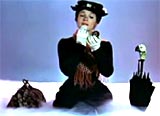 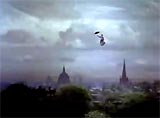 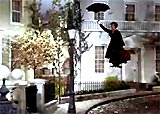
|
||||||

|
Viva Las Vegas (1964)
Director George Sidney's banal and lightweight musical was the best of all of the many Elvis musicals. Under the title credits, star singer Elvis Presley sang the city's main anthem: "Viva Las Vegas." It was advertised with the tagline: "That "Go-Go" guy and that "Bye-Bye" gal in the fun capital of the world!" The most memorable appearance and entrance was of red-headed swimming instructor Rusty Martin (Ann-Margret) (Elvis' co-star, known as "the female Elvis"), seen from under a hot-rod as she walked forward in white short-shorts into a garage. She had a memorable first conversation (with innocent sexual harrassment) with race-car driver Lucky Jackson (Elvis Presley) and smooth-talking Italian racing champ, Count Elmo Mancini (Cesare Danova), Lucky's main racing competitor in the Las Vegas Grand Prix:
She strutted directly into the camera, and then the camera
reversed itself as she walked away. They followed her sexy, swaying
bottom (seen in close-up) as she sashayed out to her white sports car.
Lucky quipped: "That's what I call a really sporty model." |
 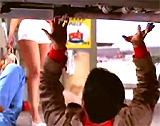 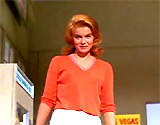 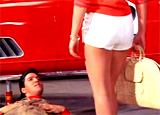 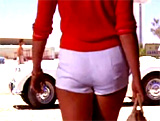
|
||||||

|
She (1965, UK)
In director Robert Day's adaptation (the 4th one) of the 1887 H. Rider Haggard adventure novel of the same name by Hammer Films, this fantasy adventure starred sexy Swedish actress Ursula Andress (dubbed by actress Monica (Nikki) Van Der Syl) as the immortal Egyptian queen and cruel high priestess Ayesha ("She-Who-Waits"). She lived in the mountain city of Kuma in E. Africa. She made two appearances, first (dressed in a slinky white sheath) to young and handsome Leo Vincey (John Richardson) in a Jerusalem house where she offered him a map and ring and tempted him to come to her after journeying across the desert and through the mountains of the moon to her fortress city. In her second appearance, she was seen on her kingdom's throne wearing an elaborate gold and feather headdress. |
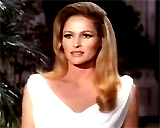 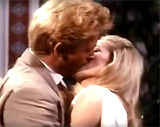 
|
||||||
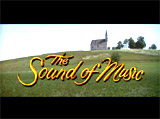
|
In the much-heralded, breathtaking opening sequence of this film, after sweeping aerial views of the snow-covered mountains and valleys, the camera moved over the European landscape and village until it discovered an open, green area nestled between the peaks. It moved closer and zoomed into the green field, where it suddenly found a happy and joyous Maria (Julie Andrews), a novice Salzburg Austrian nun, walking across the wide expanse of land. With open-armed appreciation of the beauty of the surrounding majestic peaks and vistas of the Austrian Alps, the camera cut to a medium close-up as she twirled and sang the title song: "The Hills Are Alive With the Sound of Music." |
 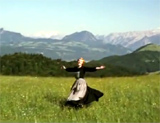 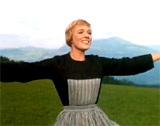 |
||||||
(chronological, by film title) Introduction | 1920s-1935 | 1936-1939 | 1940-1945 | 1946-1949 | 1950-1955 | 1956-1959 | 1960-1965 | 1966-1969 1970-1975 | 1976-1979 | 1980-1985 | 1986-1989 | 1990-1995 | 1996-1999 | 2000-2005 | 2006-Present |